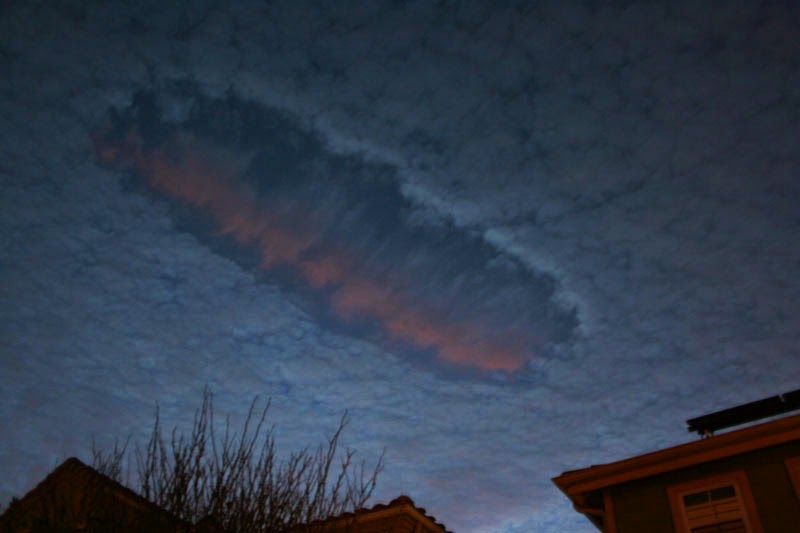A better blogger would be more punctual in sharing his projects. I continue to create presentations but rarely find time to share the content on the web. I recently presented a What's Up on the night sky to the Orange County Astronomers, which I'll share here.
Before looking at the stars, one has to look through the atmosphere, so I always share any recent observations of parhelia, that is, sun and atmosphere effects. The best example I've had recently are these iridescent clouds from late December:
As this effect occurs close the sun, please be careful to avoid looking at the sun.
And, if you start to see things, you've looked too long:
Giant multi-colored sky rodent
Turning to the night sky, here are the locations of planets, constellations, and areas I chose to discuss:
Venus (yellow) and Mars (red) linger in the west; Jupiter rises in the east. The winter milky way passing over head in the evening, but is visible only from a dark location.
Rectangles represent areas that I photographed and share below.
Comet Lovejoy is in the northwestern sky moving from Andromeda to Cassiopeia.
The green arrow shows the path of comet Lovejoy.
Along with Lovejoy, there are many other fine objects for the telescope or binoculars. Now is a good time to look from a dark location. Soon, these objects will plunge into the western horizon.
Note that on Feb 20, Lovejoy will pass near M76. The two will be worth a look through the telescope.
Here's a photo of comet Lovejoy from this week:
As a side note, while taking the above photo I captured an enjoyable coincidence:
This photo is a plane passing in front of M31. I was alarmed when I saw the photo on my camera's LCD display, for I was sure the trail was an airplane, but I hadn't identified the source of the sudden brightness. When viewing the photo on a computer, it was obvious that the flash was the Andromeda Galaxy (M31) oriented so that the long axis of its oval shape aligned with the path of the plane. Normally I don't boast of my photos of the flight path out of LAX, but this one is an exception.
In the east we see the Big Dipper, also "Ursa Major, the Big Bear" rising:
Lacking a good starry photo of the rising, leading edge of Ursa Major, I used this one taken from June of 2014 from a darker location.
Of course, when flipping a western photo to make it look like an eastern one, keep in mind the trees or any other incongruities:
A little cropping and diagramming shows the location of some worthwhile deep-sky targets for this time of year:

Each year I forget to spend quality time observing M81, M82, M108 and M97, which all require a telescope to see. The reason is that these are rising in February, when it's cold, and by late spring when I am out at a dark location, these objects are already setting in the western sky glow or lost in the trees at Palomar Observatory Campground. This year, my goal is to catch them rising, and take some photos to help me remember their qualities and locations. If I fail, there's always next year: unlike a beautiful open space on Earth, you don't have to see it before someone changes it. E.g., no one is going to enter Ursa Major with earth movers and develop it. So, it's safe to fall in love with a part of the sky, knowing it's never going to go away for good. (I once mentioned this to my former County Supervisor, who joked if there was a way to make money developing the constellations, developers would try anyway.)
The darkest part of the sky, regardless of your location, is overhead. Now, the view overhead reveals Auriga, the Charioteer:
Auriga offers some star clusters that can be found in binoculars.
However, these clusters, such as M35, are best viewed in a telescope:
No winter sky presentation is complete without calling out the location of the best nebula in the night sky, visible high in the south in binoculars as well as the telescope:
Find Orion in the south, then find its belt of three aligned stars. From there, look below the belt to the region named as Orion's sword. This region is a star cluster and nebula. Some people will see this with the naked eye, but all will see it well with binoculars.
Back to the planets, there is a delightful conjunction of Venus, Mars, and the crescent moon on Feb 20. Also, Jupiter is falling into an alignment in which the orbits of its moons can be seen edge on, making the moons pass in front of each other and making for eclipses:
Imagine Jupiter moving through it's orbit carrying it's moons with it. Our view of it's tilt will change from year to year, This year, the view appears edge on.
I recorded a similar series of eclipses 12 years ago and had the wits to document my observations. The following illustration shows my pictures of the moon Io being occulted by the shadow of the moon Ganymede.
Happy star gazing, and local viewers may want to plan to attend the Wildomar star party at Marna O'Brien Park on April 25, 2015.
jg































